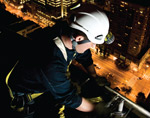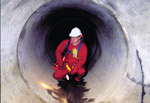
By Lynn Feiner
If there are no contaminants at your worksite or the concentration levels are below the Permissible Exposure Limit (PEL), you, as the employer or Respiratory Protection Program Administrator, may allow your employees to wear respirators for relief from nuisance dusts or other contaminants, including relief from nuisance odors. But before you give the go-ahead, you need to know what your responsibilities are and the options you have as the Employer/Program Administrator.

By Daryn Lewellyn
Instead of focusing on safety (i.e., the avoidance of employee injury), many safety managers are focused on compliance (i.e., the avoidance of regulatory action taken against them). To put it another way, compliance-first is a mindset that asks, "What do I need to do to stay safe in the eyes of the government?" while a safety-first mindset frames the issue more simply: "What do I need to do to stay safe?"

By Paul Moraski, Mary Watters
No two ways about it: Masonry is hard work and stressful on the body. Masonry workers have the highest rate of back injuries causing days away from work among all of the construction trades. The rate is more than one and a half times higher than the average rate for all construction workers.

By Kevin Denis
One of the questions most frequently asked is, "What kind of training do I need to be a Competent Person in regard to fall protection?" Although it seems like a straightforward question, the answer can be a little tricky. Many people believe the singular requirement to achieve Competent Person status is completion of a fall protection course, but it's just not that simple.

By Sarah Ursulan
Confined space entry presents a potential hazard in numerous industries. Whether it is an inspection of an aircraft fuel tank, entering the hold of a barge, working in an underground utility vault, or cleaning a wine fermentation tank, education and safety are important when entering confined spaces.

By Marc Barrera
The popular image of a bodyguard is someone 3-feet thick wearing a black suit and tie, impenetrable sunglasses, and whispering into a wrist phone. Thanks to Hollywood, many of us immediately picture Kevin Costner carrying Whitney Houston through an unruly crowd of fans, but nothing could be further from the truth.

By Scott Larson
With the recent outbreak of H1N1 virus around the globe, there has been increased interest in using respirators to help protect people at work, at home, and while out in public. While most people have seen or used respirators, few people truly appreciate and understand how these apparently simple devices actually work and what is required to use them properly in order to receive the expected protection that they can offer.
By Robert Pater
Ever find that what initially seems like a good thing just backfires? This is more likely to happen with an intervention when leaders haven't thoroughly thought it through.